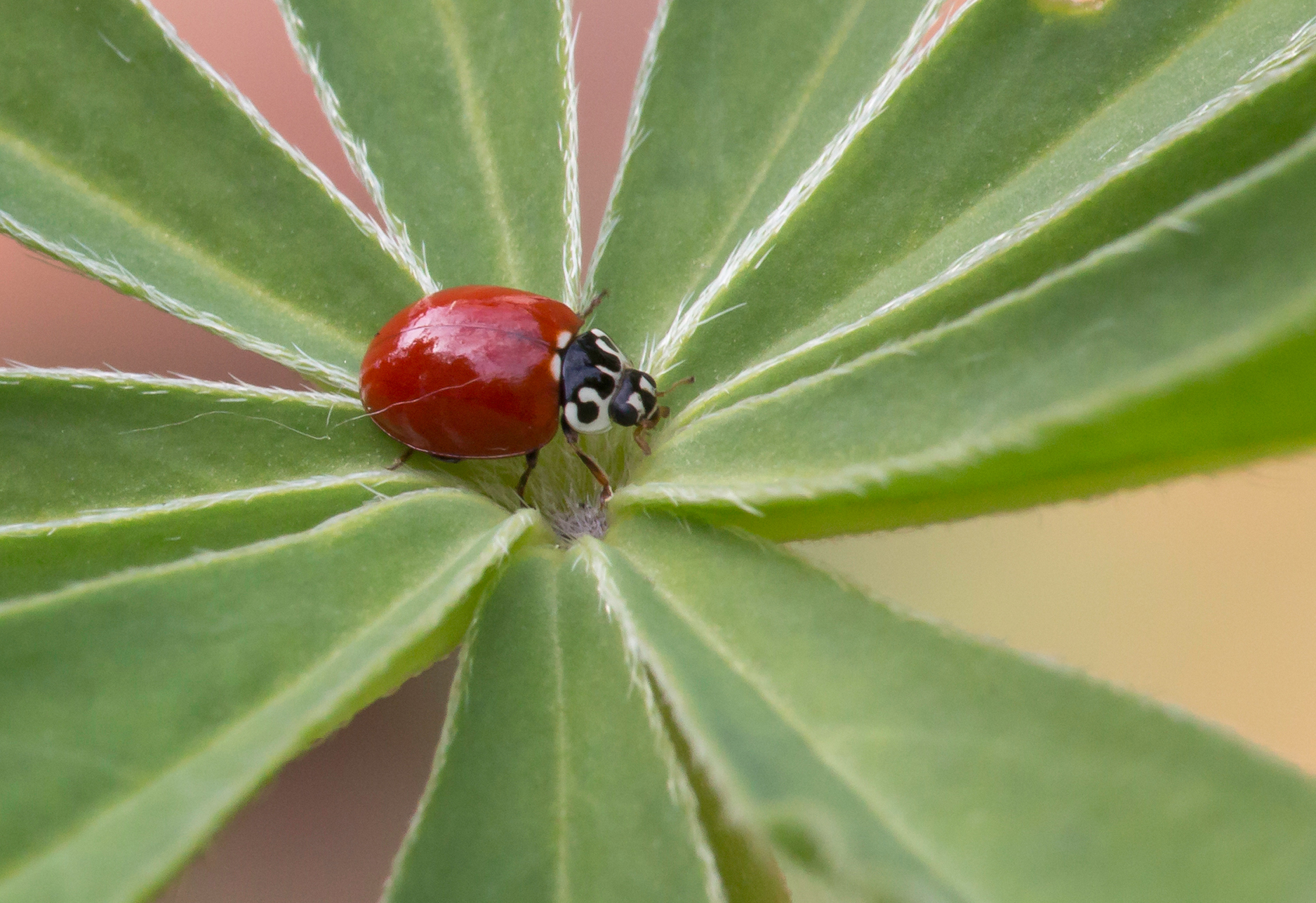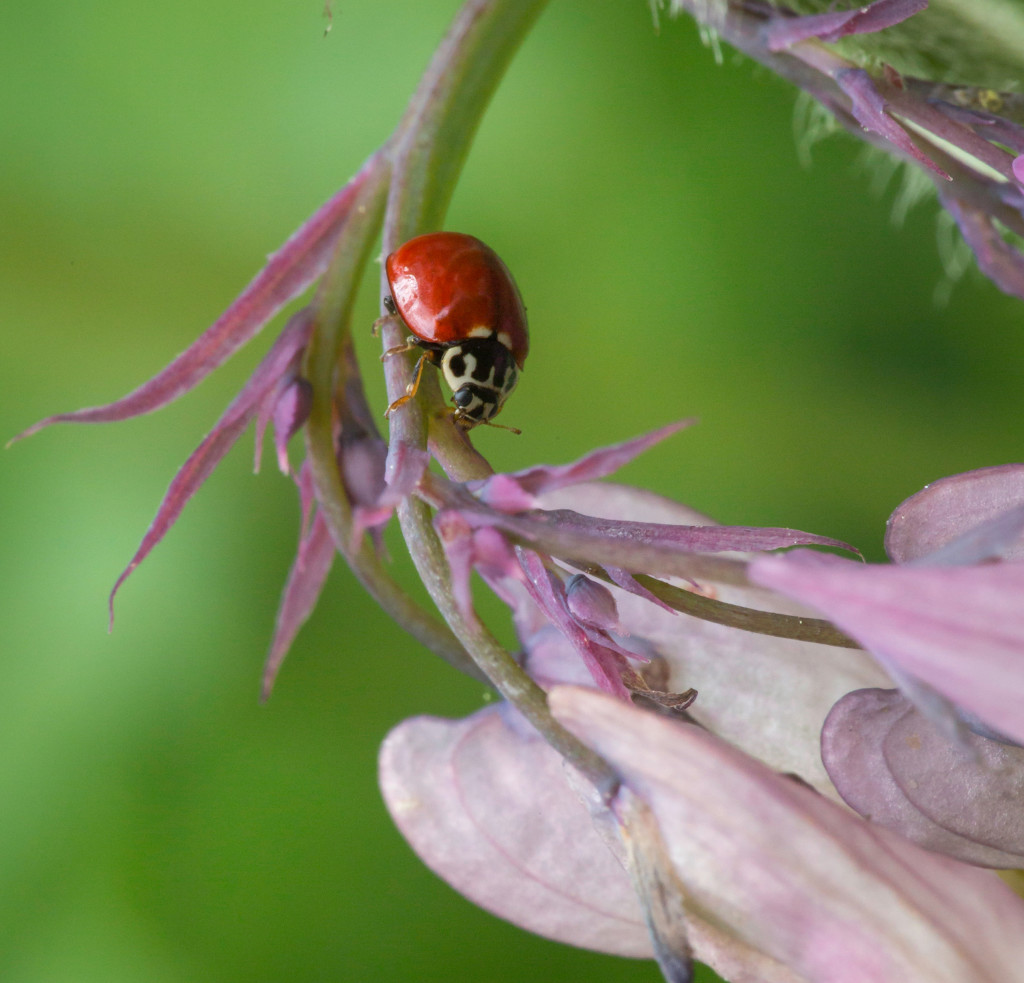
The Western blood-red ladybird beetle (Cycloneda polita) — one of about 90 species throughout the Pacific Northwest and about 6,000 species worldwide — is tiny (4 to 5 mm), but like most others in the Coccinellidae family, is a voracious consumer of aphids, scale insects, and mites; a few species eat fungi. Revered for centuries due to their role as a pest controller, ladybird beetles at one time were even thought to have supernatural powers. The “lady” for whom they were named was the “Virgin Mary.” Once you have these native predators in your garden you’ll want to keep them, and there’s an easy way to do that.
But first, a little about these endearing little insects, the vast majority of which are beneficial: The most obvious ladybird beetles (often called “ladybugs” in North America, although they are not true bugs) evolved a brightly colored shell to exhibit what biologists call aposematic (warning) coloration, which functions to repel and warn predators that they taste awful (due to production of toxic and unpalatable alkaloids). The “eyespots” on their pronotum (that covers the thorax) are a form of mimicry, possibly to further fool a predator by appearing dangerous, or by adding to the inedibility factor. Their actual face is the tiny black and white portion with brown antennae that you can see in the photo above. The Western blood-red ladybird beetle is plain and without spots, but some species have remarkable color patterns that vary greatly and make identification difficult. Other species lack dramatic coloration.
Life Cycle
Adults are commonly seen on plants in spring and summer, foraging for small invertebrate prey (often aphids), although they will eat nectar, water, or honeydew (the sugary secretion from insects like aphids and white flies) when food is scarce. They overwinter by hibernating in large clusters, often spending the winter under leaf litter, rocks, downed wood, or other debris. If they get into your house in autumn as temperatures plummet, please don’t kill them. Since they need cool temperatures and moisture during the winter (which our homes lack), gently place them back outside under fallen leaves. In hard to reach places (like ceilings) I suggest fastening a piece of lightweight fabric (perhaps a lightweight sock or piece of nylon stocking) onto the end of a vacuum cleaner hose with a rubber band, so that an inch or two of fabric protrudes into the hose. Then, with the power turned down as low as possible, quickly suck them into the fabric, gently remove the fabric with the beetles, and release them under a pile of leaves outdoors. To help prevent future interlopers, caulk cracks and crevices around doors and windows and repair any damaged siding that’s allowing them to get in.
Ladybird beetle larvae are long and flat and are usually covered with little spines, spots and stripes, and resemble tiny alligators. Though sometimes erroneously mistaken for pests, they are completely harmless to humans. Usually found in or near aphid colonies, they feed voraciously on insects for several weeks, then pupate on leaves. Some species produce several generations per year, while others have only one. During the summer, all stages may be seen.
How to Acquire
The best way to get these hungry predators into your garden is not to purchase them, but to provide native habitat and not use any insecticides. The food that they need comes from native plants that naturally attract insect herbivores. In my yard I notice Cycloneda polita (pictured) feeding on lupine (Lupinus spp.), western bleeding heart (Dicentra formosa), fleabane (Erigeron spp.), honeysuckle vines (Lonicera ciliosa and L. hispidula), and this year for the first time, aspen trees (which are also attracting birds like bushtits and kinglets who love to eat aphids).
Don’t buy them
In the early 1900’s, literally tons of Asian beetles were collected and shipped to agricultural fields. Tragically, over half died during shipments and most of the rest quickly dispersed before the wretched experiment finally ended. Today, ladybird beetles are again popular, but beware the ramifications. According to Judy and Peter Haggard, authors of “Insects of the Pacific Northwest” (Timber Press, 2006), the commercial exploitation of ladybird beetles involves collecting them while they are hibernating, which can be devastating to their populations. “Those innocent-looking mesh bags … in the local garden shop actually represent a cruel and unconscionable practice: Ladybird beetles sold in retail stores are usually exposed to high temperatures, low humidity, and no food for weeks. Even if they survive until bought and released, they are often so weakened, they die soon after being released.” And the ones who do survive usually quickly disperse to areas other than your yard. Bottom line: Don’t purchase them.
To add to the destruction, beetles sold commercially are usually not native species and, as such, are a serious threat to native insect species, including native lady beetles. According to the Oregon Department of Agriculture, “Even species native to North America but collected outside of Oregon should not be released because they may carry diseases and parasites not found in Oregon.”
Thank you for enlightening me on the dangers of store bought ladybugs, I was buying them yearly. I apologize.